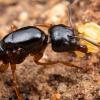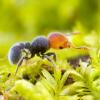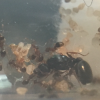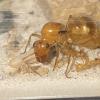Here is a website on how to care for them: http://www.amphibian...uk/batrach.html.
It says "Due to the small gape of these salamanders, food consists mainly of small insects, preferably aphids, fruitflies, spiders and small crickets. They will also take hatchling waxworm, freshly sloughed mini-mealworm and caterpillars. Crickets should be gut-loaded with carrots, oranges and other nutritients. Food can be dusted every other sitting with a vitamin supplement such as Rep-Cal. Although regularly making brief daytime forages, slender salamanders hunt chiefly at night so introduce a sufficient number of these food items during dusk."
Here is another site for a species in the genus: http://www.californi...attenuatus.html.
It says "Diet consists of a variety of invertebrates, including springtails, small beetles, snails, mites, spiders, and isopods. A sit-and-wait predator, catching prey with a projectile tongue."
This also would go in General Off-Topic as you're asking for help with Slender Salamanders.
Please do some research on the animals you want to keep before you get them.
Edited by Zeiss, January 5 2021 - 4:47 PM.























